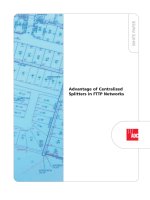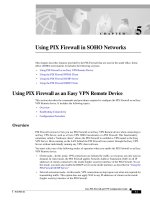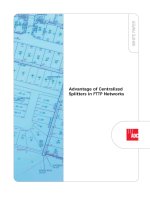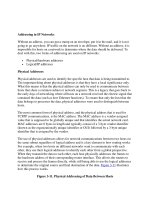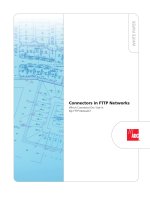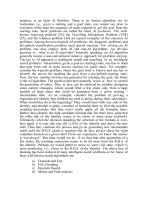Soft computing applications in sensor networks
Bạn đang xem bản rút gọn của tài liệu. Xem và tải ngay bản đầy đủ của tài liệu tại đây (6.24 MB, 306 trang )
SoftComputingApplicationsinSensorNetworks
SoftComputingApplicationsinSensor
Networks
Editedby
SudipMisra
SankarK.Pal
CRCPress
Taylor&FrancisGroup
6000BrokenSoundParkwayNW,Suite300
BocaRaton,FL33487-2742
©2017byTaylor&FrancisGroup,LLC
CRCPressisanimprintofTaylor&FrancisGroup,anInformabusiness
NoclaimtooriginalU.S.Governmentworks
Printedonacid-freepaper
VersionDate:20160513
InternationalStandardBookNumber-13:978-1-4822-9875-8(Hardback)
This book contains information obtained from authentic and highly regarded sources. Reasonable efforts have been
madetopublishreliabledataandinformation,buttheauthorandpublishercannotassumeresponsibilityforthevalidity
of all materials or the consequences of their use. The authors and publishers have attempted to trace the copyright
holdersofallmaterialreproducedinthispublicationandapologizetocopyrightholdersifpermissiontopublishinthis
formhasnotbeenobtained.Ifanycopyrightmaterialhasnotbeenacknowledgedpleasewriteandletusknowsowe
mayrectifyinanyfuturereprint.
Except as permitted under U.S. Copyright Law, no part of this book may be reprinted, reproduced, transmitted, or
utilized in any form by any electronic, mechanical, or other means, now known or hereafter invented, including
photocopying, microfilming, and recording, or in any information storage or retrieval system, without written
permissionfromthepublishers.
For permission to photocopy or use material electronically from this work, please access www.copyright.com
( or contact the Copyright Clearance Center, Inc. (CCC), 222 Rosewood Drive, Danvers,
MA01923,978-750-8400.CCCisanot-for-profitorganizationthatprovideslicensesandregistrationforavarietyof
users. For organizations that have been granted a photocopy license by the CCC, a separate system of payment has
beenarranged.
TrademarkNotice: Product or corporate names may be trademarks or registered trademarks, and are used only for
identificationandexplanationwithoutintenttoinfringe.
LibraryofCongressCataloging-in-PublicationData
Names:Misra,Sudip,editor.|Pal,SankarK.,editor
Title:Softcomputingapplicationsinsensornetworks/editors,SudipMisra.andSankarK.Pal.
Description:BocaRaton:Taylor&Francis,aCRCtitle,partoftheTaylor&Francisimprint,amember
oftheTaylor&FrancisGroup,theacademicdivisionofT&FInforma,plc,[2017]|Includes
bibliographicalreferencesandindex.
Identifiers:LCCN2016008478|ISBN9781482298758(alk.paper)
Subjects:LCSH:Wirelesssensornetworks--Computerprograms.|Softcomputing.
Classification:LCCTK7872.D48S6352017|DDC004.6--dc23
LCrecordavailableat />VisittheTaylor&FrancisWebsiteat
andtheCRCPressWebsiteat
DedicatedtoOurFamilies
Contents
Preface
ListofFigures
ListofTables
Editors
Contributors
IIntroduction
1IntroductiontoWirelessSensorNetworks
SankarN.Das,SamareshBera,SudipMisra,andSankarK.Pal
1.1Introduction
1.2ClassificationofWSNs
1.2.1SpecificApplications
1.2.2TransmissionMedia:RadioFrequency,Acoustic,andOthers
1.2.3TypesofNodes:Static,Mobile,andMultimedia
1.2.4TypesofNetworks
1.3ApplicationsofWSNs
1.3.1Military
1.3.2Environmental
1.3.3HealthCare
1.3.4Industrial
1.3.5Agriculture
1.3.6VehicularNetworks
1.3.7SmartHomes
1.4KeyFactors
1.4.1SystemRequirements
1.4.2CategoriesofWSNs
1.4.3ProtocolStackofWSNs
1.4.4TopologyManagement
1.4.5Coverage
1.4.6ImportantFactorsRelatedtoCommunication
1.4.7FaultTolerance
1.4.8Security
1.5ConcludingRemarks
Bibliography
2AdvancesinSoftComputing
DebasisSamantaandGaurangPanchal
2.1Introduction
2.1.1BasicConceptofSoftComputing
2.1.2HybridComputing
2.2FuzzyLogic
2.2.1BasicConceptofFuzzyLogic
2.2.2FuzzyLogicController
2.2.2.1Fuzzification
2.2.2.2Defuzzication
2.3ArtificialNeuralNetworks
2.3.1BasicConcepts
2.3.2NeuralNetworkArchitecture
2.3.3ANNTrainingandLearning
2.3.3.1TypesofLearning
2.3.3.2SingleLayerFeedForwardNNTraining
2.4EvolutionaryAlgorithms
2.4.1TraditionalApproachestoOptimizationProblems
2.4.1.1EvolutionaryComputing
2.4.1.2GeneticAlgorithm(GA)
2.4.2MultiobjectiveOptimization
2.4.2.1GA-BasedMultiobjectiveOptimization
Bibliography
IIFundamentalTopics
3EvolutionofSoftComputingApplicationsinSensorNetworks
PriyankaSharmaandGarimellaRammurthy
3.1Introduction
3.2OverviewofSoftComputinganditsApplications
3.2.1DefinitionofSoftComputing
3.2.2SoftComputingandHybridization
3.2.3KeyElementsofSoftComputing
3.2.4SignificanceofSoftComputing
3.2.5GoalsofSoftComputing
3.2.6ApplicationsofSoftComputing
3.3SensorNetworksandSoftComputingApplications
3.3.1IntrusionDetection
3.3.2Localization
3.3.3OptimizationofWSNs
3.3.4AppliedSystems
3.4CaseStudies:VariedImplementationofSoftComputingApplicationsinSensor
Networks
3.4.1CaseStudy1:SmartNodeModelforWirelessSensorNetwork
3.4.1.1SmartNodeinWSNControl
3.4.2UsingSNforFuzzyDataBaseDesigning
3.4.2.1UsingSNforDataAggregationandFusion
3.4.3CaseStudy2:SoftComputingProtocolsforWSNRouting
3.4.3.1ReinforcementLearning
3.4.3.2SwarmIntelligence
3.4.3.3EvolutionaryAlgorithms
3.4.3.4FuzzyLogic
3.4.3.5NeuralNetworks
3.4.3.6ArtificialImmuneSystems
3.5FutureScopeofSoftComputingApplicationsinSensorNetworks
3.6Summary
Bibliography
4SoftComputingApproachesinWSNRoutingProtocols
KonjetiViswanadh,MunjuluriSrikanth,andGarimellaRammurthy
4.1Introduction
4.2RoutingProtocols:ClassificationandOverview
4.2.1RoutingProtocolsBasedonNetworkStructure
4.2.2RoutingProtocolsBasedonProtocolOperation
4.3Challenges
4.3.1RoutingEfficiencyLimitations
4.3.2EnergyLimitations
4.3.3OtherFactors
4.4SoftComputingBasedAlgorithms
4.4.1CaseforSoftComputingAlgorithmsinWSNs
4.4.2DifferentSoftComputingAlgorithms
4.4.2.1ReinforcementLearning(RL)
4.4.2.2SwarmIntelligence(SI)
4.4.2.3EvolutionaryAlgorithms(EAs)
4.4.2.4FuzzyLogic(FL)
4.4.2.5NeuralNetworks(NNs)
4.5ResearchDirections
4.6Conclusion
Bibliography
5Fault-TolerantRoutinginWSNs
P.VenkataKrishnaandV.Saritha
5.1Introduction
5.2LearningAutomata-BasedFault-TolerantRoutingProtocol
5.2.1LearningAutomata
5.2.1.1Introduction
5.2.1.2Automaton
5.2.1.3Environment
5.2.2CrossLayerDesign
5.2.3DynamicSleepScheduledCrossLayeredLearningAutomata-Based
ApproachtoPreventDoSAttacks
5.2.3.1NetworkModel
5.2.3.2LearningAutomatonModel
5.2.3.3Algorithm
5.2.3.4StrategytoReduceControlPacketOverhead
5.2.3.5LearningPhase
5.2.3.6SleepScheduling
5.3AntColony-BasedFault-ToleranceRouting
5.4NeuralNetwork-BasedFault-TolerantRoutingAlgorithms
5.4.1NeuralNetworkApproachforFaultTolerance
5.4.1.1Illustration
5.4.2ConvergecastRoutingAlgorithm
5.4.2.1SelectionofClusterHead
5.4.2.2DeterminationofReliablePaths
5.4.2.3ConstructionofConvergecastTree
5.4.2.4Illustration
5.4.2.5ConstructionofConvergecastTreeUsingHNN
5.5Conclusions
Bibliography
6MathematicalAnalysisofWSNsUsingGameTheory:ASurvey
HindolBhattacharya,SamiranChattopadhyay,andMatanginiChattopadhyay
6.1Introduction
6.2GameTheory:AShortIntroduction
6.2.1GameTheoryinBrief
6.2.1.1CooperativeandNon-CooperativeGame
6.2.1.2ZeroSumandNon-ZeroSumGame
6.2.1.3RepeatedGames
6.2.1.4CompleteandIncompleteInformationGame
6.2.2Prisoner’sDilemma
6.2.3NashEquilibrium
6.2.4ParetoOptimality
6.2.5UseinComputerScience
6.3ApplicationofGameTheoryinChannelContentionControl
6.3.1Game-BasedEnergyEfficientMACProtocol(G-ConOpt)
6.3.2GameTheory-BasedImprovedBackoffAlgorithmforEnergyEfficient
MACProtocol
6.3.3GameTheory-BasedEfficientWirelessBodyAreaNetwork
6.4ApplicationofGameTheoryinaClusteredWSN
6.4.1GametoDetectSelfishnessinClusters(CROSS)
6.4.2LocalGame-BasedSelfishnessDetectioninClustering(LGCA)
6.4.3GameforClusterHeadSelection
6.4.4GameforEnergyEfficientClustering
6.5ApplicationofGameTheoryinConnectionandCoverageProblem
6.5.1NetworkCoverageGame
6.6ApplicationofGameTheoryinSecurityandReliabilityofWSNs
6.6.1DoSGame
6.6.2JammingGame
6.6.3MaliciousNodeDetectionUsingZeroSumGame
6.6.4SelectiveForwardPreventionGame
6.7ConcludingRemarks
Bibliography
7OptimalClusterHeadPositioninginHeterogeneousSensorNetworks
BiswanathDey,SandipChakraborty,andSukumarNandi
7.1Introduction
7.2RelatedWorks
7.3CHPP:SystemModelandMulti-ObjectiveProblemFormulation
7.4CHPP:EvolutionaryMulti-ObjectiveOptimizationandParetoOptimality
7.4.1ProblemDecomposition
7.4.2InitializationforEvolutionaryOptimization
7.4.3GeneticOperations
7.4.3.1SelectionOperator
7.4.3.2CrossoverOperator
7.4.3.3MutationOperator
7.4.3.4RepairOperator
7.4.4TerminationCondition
7.5PerformanceEvaluation
7.6Conclusion
Bibliography
IIIAdvancedTopics
8UbiquitousContextAwareServices
P.VenkataKrishna,V.Saritha,andS.Sivanesan
8.1Introduction
8.2ContextAwarenessinWSNs
8.3ArchitectureforPrecisionAgriculture
8.4ContextExtractionUsingBayesianBeliefNetworks
8.4.1BayesianBeliefNetworks(BBN)
8.4.2OnlineDataCleaningforContextExtraction
8.5Self-OrganizingMap-BasedContextIdentification
8.5.1Unsupervised,DynamicIdentificationofPhysiologicalandActivity
ContextinWearableComputing
8.5.2OfflineAlgorithm
8.5.3OnlineAlgorithm
8.6NeuralNetworkModelforContextClassificationinMobileSensorApplications
8.6.1ContextRecognitioninWirelessSensorNetworks
8.6.2CONSORTS-S:MobileSensingPlatform
8.6.3MobileHealthCareServices
8.7Conclusion
Bibliography
9SmartAlgorithmsforEnergy-AwareWirelessBodyAreaNetworksinHealthCare
Delivery
ErnestoIbarra,AngelosAntonopoulos,ElliKartsakli,andChristosVerikoukis
9.1Introduction
9.2Timeliness
9.3MobileHealth(mHealth)
9.4WBANs:ChallengesandOpenIssues
9.5BodySensorNodes(BNs)
9.5.1BNCharacteristics
9.5.2BNEnergyConsumption
9.5.3EnergyEfficiencyinWBANs
9.5.4SmartEnergy-AwareAlgorithmsforBNs
9.5.5BNsPoweredbyHumanEnergyHarvesting(HEH)
9.6MediumAccessControl(MAC)Mechanisms
9.6.1MACProtocolsforWBANs
9.6.2MACProtocolsforHEH-PoweredWBANs
9.7NovelMACProtocolDesignforHEH-WBANs
9.7.1AHybridPollingHEH-PoweredMACProtocol(HEH-BMAC)
9.7.1.1SystemModel
9.7.1.2ProtocolOverview
9.7.1.3OperationExample
9.7.1.4HEH-BMACwithEnergySaving
9.7.1.5PerformanceEvaluation
9.7.1.6Conclusions
9.7.2ASmartAlgorithmforHEH-PoweredBNs(PEH-QoS)
9.7.2.1SystemModel
9.7.2.2Power-QoSAwareManagementAlgorithm
9.7.2.3PerformanceEvaluation
9.7.2.4Conclusions
9.8ConcludingRemarksonSoftComputingPotential
Acknowledgments
Bibliography
10ComplexNetworkEntropy
PritiSingh,AbhishekChakraborty,andB.S.Manoj
10.1Introduction
10.2ReviewofExistingStrategies
10.2.1EntropyBasedonNodalDegree
10.2.1.1EntropyofDegreeSequence
10.2.1.2EntropyofDegreeDistribution
10.2.2EntropyBasedonTopologyConfiguration
10.2.3NetworkConnectivityEntropy
10.2.4NetworkCentralityEntropy
10.2.5ClusteringEntropy
10.2.6EntropyBasedonNumberofCyclesandLoops
10.2.7NavigationEntropy
10.2.8EntropyBasedonAutomorphismPartition
10.2.9EntropyasMeasureofNetworkEvolution
10.2.9.1Degree-BasedEntropyasMeasureofNetworkEvolution
10.2.9.2Robustness-BasedEntropyasMeasureofNetworkEvolution
10.3LinkLengthVariabilityEntropy
10.4ComparisonofVariousEntropyDefinitions
10.5Conclusion
Bibliography
11IntelligentTechniqueforClusteringandDataAcquisitioninVehicularSensor
Networks
AmitDua,NeerajKumar,andSeemaBawa
11.1Introduction
11.1.1Organization
11.2MobilityModelsforDataCollection
11.3Clustering
11.4DataCollectionwithMobilityinVANETs
11.5IssuesinVANETs
11.5.1Mobility
11.5.2Scalability
11.5.3ChannelUtilization
11.5.4SecurityandPrivacy
11.5.5InefficientManagementofData
11.6SimilaritiesandDifferencesofVANETsandMANETs
11.6.1ComparisonofCharacteristics
11.7VANETsApplications
11.8SimulationTools
11.9Conclusion
Bibliography
Index
Preface
OverviewandGoals
Softcomputingisanemergingmethodologyforrobustandcost-effectiveproblemsolving
involvinguncertainenvironments.Thedifferentfeaturesofsoftcomputingfacilitaterealtime information processing in the presence of such environments. Thus, several solution
techniques,suchasfuzzylogic,antcolonyoptimization,particleswarmoptimization,and
genetic algorithms, have major impacts in solving problems where precise mathematical
modelsareunavailable.
Concurrently, sensor networking is popular for real-time monitoring involving remote
sensing,ubiquitoushealthmonitoring,targettracking,andlocalization.Asensornetworkis
anintegrationoftypicallyheterogeneoussensors(hardware)withwirelesscommunication
infrastructure, middleware, and software tools. The general problem can be broken down
intoseveralsteps,includingchannelaccess,routing,dataaggregation,locationestimation,
andtargettracking,whilesensornodesareknownasenergyconstraintdevices.
Recently, soft computing methodologies, such as fuzzy logic and ant colony
optimization, are demonstrated to be promising for solving different problems in sensor
networks such as efficient learning and uncertainty handling. Several conference and
journalpapersonapplyingsoftcomputingtechniquesinsensornetworkinghaveappeared
inthepastfewyears.Theydescribevariouschallengingissuesrelatedtosensornetworking
using soft computing techniques. Moreover, different researchers address the problems
from different perspectives. Therefore, there has been a need for a book describing in a
consolidatedmanner themajorrecenttrendsofsoftcomputingtoprovidecomprehensive
informationtoresearchers,appliedscientists,andpractitioners.
This handbook is written by worldwide experts, with the aim of bringing together
research works describing soft computing approaches in sensor networking, while
investigating the novel solutions and discussing the future trends in this field. It includes
tutorials and new material that describe basic concepts, theory, and algorithms that
demonstratewhyandhowsoftcomputingtechniquescanbeusedforsensornetworkingin
different disciplines. All the chapters provide a balanced mixture of methodologies and
applications. After a brief tutorial-style introduction, each chapter contains a
comprehensive description of the developments in its respective area, and is written to
blendwellwiththeotherchapters.
This book is useful to graduate students, researchers, and practitioners working in
differentfieldsspanningcomputerscience,systemscience,andinformationtechnology,as
areferencebookandasatextbook.
OrganizationandFeatures
The book is broadly divided into three parts. Part I consists of two chapters. Chapter 1
presents preliminary concepts of sensor networks. Chapter 2 is dedicated to the recent
advances in soft computing. Part II, comprised of five chapters, focuses on the recent
advances in soft computing applications in sensor networks. Chapter 3 discusses the
evolutionofsoftcomputinginsensornetworksindifferentapplicationscenarios.Chapters
4and5discussroutingmechanismsinsensornetworksusingsoftcomputingapplications.
Chapter6describesgametheoreticaspectsinwirelesssensornetworks.
Chapter 7 is dedicated to energy efficiency and bounded hop data delivery in sensor
networksusingamulti-objectiveoptimizationapproach.PartIIIconsistsoffourchapters,
andisdedicatedtotheadvancedtopicsinsensornetworksinwhichdifferentproblemscan
bepotentiallysolvedusingsoftcomputingapplications.Chapter8discussescontextaware
servicesinsensornetworks.Chapter9presentsenergy-awarewirelessbodyareanetworks
(WBANs)forcriticalhealthcareinformationdelivery,whilepresentingdifferentaspectsof
soft computing applications in WBANs. Chapter 10 is dedicated to the complex network
entropy in the context of sensor networks. Finally, Chapter 11 discusses challenges and
possibilitiesofsoftcomputingapproacheswhichareapplicableforadhocsensornetworks
specificallyforvehicularnetworks(VANETs).
Welistsomeoftheimportantfeaturesofthisbook,which,webelievemakethisbooka
valuableresourcetoourreaders.
• Most chapters are written by prominent academicians, researchers, and practitioners
workinginrespectivetopicalareasforseveralyearsandhavethoroughunderstanding
oftheconcepts.
• Most chapters focus on future research directions and target researchers working in
these areas. They provide insight to researchers about some of the current research
issues.
• The authors represent diverse nationalities. This diversity enriches the book by
includingideasfromdifferentpartsoftheworld.
•Attheendofeachchapter,weincludedadditionalliterature,whichreaderscanuseto
enhancetheirknowledge.
TargetAudience
Thisbookiswrittenforthestudentcommunityatalllevelsfromthosenewtothefieldto
undergraduatesandpostgraduates.Itisdesignedtobeusefulatalllearninglevels.
The secondary audiences for this book are the research communities in both academia
and industry. To meet the specific needs to these groups, most chapters include sections
discussingdirectionsoffutureresearch.
Finally,wehaveconsideredtheneedsofreadersfromtheindustrieswhoseekpractical
insights, for example, how soft computing applications are useful in real-life sensor
networks.
ListofFigures
1.1Networkarchitectureofwirelesssensornetwork
1.2Classificationofwirelesssensornetworks
1.3Intruderdetectionatborderofregion
1.4Trackingtargetonbattlefield
1.5Wirelesssensornetworkinagriculture
1.6Vehicularnetwork
1.7Smarthomeequippedwithdifferentsensors
1.8Sensornode
1.9ProtocolstackofWSN
1.10Examplesofdifferenttopologies
1.11Differenttypesofcoveragewithinarea
2.1Conceptofcomputing
2.2Conceptofhybridcomputing
2.3Universeofdiscourse
2.4Fuzzylogiccontroller
2.5Navigationofrobot
2.6Fuzzificationofinputs
2.7Fuzzyoutput
2.8Combinedfuzzifiedoutputforallfourredrules
2.9Humanbrain
2.10Artificialneuronanditsinput
2.11Thresholdingfunctions
2.12Otherthresholdingfunctions
2.13Sampleneuron
2.14Recurrentneuralnetworkarchitecture
2.15Linearlyseparableandnon-separablepoints
2.16Classificationoflearningtechniques
2.17Traditionalapproachestosolveoptimizationproblem
2.18Typesofsearchingalgorithm
2.19Frameworkofsimplegeneticalgorithm
2.20Non-dominatedsortinggeneticalgorithm
2.21Paretooptimal
2.22Paretofront
2.23Flowchartofevolutionarymultiobjectiveoptimization
2.24Non-dominatedsortinggeneticalgorithm(NSGA)
3.1Elementsofhybridizationinsoftcomputing
4.1Comparisonofsoftcomputingalgorithms
5.1Interactionsofcomponentsofnodeandneighboringnode
5.2Systemstrategyforcontrolpacketoverhead
5.3BAMarchitecture
5.4SampleWSN
5.5Convergecasttree
7.1CHPPsolutionsetandParetooptimality
7.2Initializationofchromosomesforevolutionaryoptimization
8.1Sampleworkflow
8.2Samplecontextualinformationoffarminglifecycle
8.3PerformanceanalysisformanualandCAM-basedpaddycultivation
9.1RelationbetweenIEEE802.15.6andotherwirelessstandards
9.2 Example of WBAN in an mHealth system: the collected data are transmitted
wirelesslytoanexternaldevice(e.g.,asmartphoneoraPDA)
9.3Bodysensornetworks
9.4MedicalWBANs:datatransmissionratesandaveragepowerconsumptioncompared
tootherwirelesstechnologies
9.5DistributionofpowerconsumptionwhenasampledsignalistransmittedbyECG
9.6PowerconsumptionofkeyoperationmodesinawirelessBN
9.7Contention-freemultiple-accessmethods:(a)TDMA,(b)FDMA,and(c)CDMA
9.8TimingdiagramofpureandslottedALOHA
9.9HEH-WBAN:systemmodelandnetworktopology
9.10 ID polling access mode: (a) data communication process and (b) ID-BN states and
transmission
9.11 PC access mode: (a) data communication process when X
9.12DynamicschedulealgorithmforIDpollingandPCaccessperiodsinHEH-BMAC
9.13FrameexchangeinHEH-BMAC
9.14Simulationscenario
9.15 Physical layer frame structures: (a) polling packet, (b) data packet, and (c) ACK
packet
9.16HEH-BMACvs.IEEE802.15.6:energyefficiency
9.17HEH-BMACvs.IEEE802.15.6:normalizedthroughputs
9.18HEH-BMACvs.IEEE802.15.6:normalizedthroughput
9.19BN’sarchitectureandWBANtopology:systemmodel
9.20IllustrationofthePEH-QoSoperation
9.21PHAMsub-modulealgorithm
9.22DQACsub-modulealgorithm
9.23PASSsub-modulealgorithm
9.24IEEE802.15.6dataframestructure
9.25Detectionefficiency
9.26Dataqueuebehavior
9.27Storageefficiency
9.28Normalizedthroughput
9.29Normalizedthroughputvs.DLoad
9.30Datapacketloss
9.31Averagepacketend-to-enddelay
9.32Energyspentperdatatransmission
9.33Energyefficiency
9.34Packetloss
9.35Averagepacketend-to-enddelay
10.1Degreesequence-basedentropy
10.2ERrandomnetworkconfigurations:(a)networkwithlinkprobabilityp=0.5and(b)
networkwithlinkprobabilityp=0.1
10.3 Connectivity entropy: (a) connected network, (b) disconnected network, and (c)
disconnectednetworkwithisolatednode
10.4Centralityentropy
10.5Clusterentropy
10.6Partiallyconnectedcyclicnetwork
10.7Navigationentropy:(a)linenetworkand(b)starnetwork
10.8Entropybasedonautomorphismpartition
10.9Entropybasedonlinklengthvariability
11.1Schematicdiagramofvehiclesandinterconnectionbetweenvehicles
11.2Variationinpacketdeliveryratiowithincreasingvelocityanddensity
11.3Variationinpacketdeliveryratiowithincreasingvelocityandnumberofsensors
11.4Classificationofvariousmobilitymodels
ListofTables
1.1MoteHardwareSpecifications
1.2CommonAttacksinWirelessSensorNetworks
2.1BooleanANDOperation
7.1ParameterSettingsforEvolutionaryOptimization
7.2AverageDataForwardingDelay(ms)
7.3AverageEnergyConsumption(Watt-Hour)
7.4ConvergenceandOptimalityRatioAnalysis
9.1BNSimulationParameters
9.2MACProtocolParameters
9.3ECGBNCharacteristics
9.4SimulationParameters
10.1CentralityValuesforNetworkShowninFigure10.4
10.2QualitativeComparisonofVariousEntropyDefinitions
11.1RelativeComparisonofMobilityModels
11.2ComparisonofSimulators
Editors
Dr.SudipMisraisanAssociateProfessorintheSchoolofInformationTechnologyatthe
Indian Institute of Technology Kharagpur. He earned a Ph.D. in Computer Science at
Carleton University, Ottawa, Canada. His current research interests include algorithm
design for emerging communication networks. He is the author of over 170 scholarly
researchpapers,morethan80ofwhichwerepublishedbyreputableorganizationssuchas
IEEE,ACM,Elsevier,Wiley,andSpringer.
Dr.Misra’sworkwasrecognizedatvariousconferences.HereceivedtheIEEEComSoc
Asia Pacific Outstanding Young Researcher Award in 2012. He was also the recipient of
several academic awards and fellowships including the Young Scientist Award of the
NationalAcademyofSciencesofIndia,theYoungSystemsScientistAwardoftheSystems
Society of India, the Young Engineers Award of the Institution of Engineers, Carleton
University’sGovernorGeneral’sAcademicGoldMedalawardedtoanoutstandinggraduate
student doctoral level, and the Swarna Jayanti Puraskar Golden Jubilee Award of the
NationalAcademyofSciencesofIndia.Dr.MisraalsoreceivedaprestigiousNSERCpostdoctoralfellowshipfromtheCanadiangovernmentandaHumboldtresearchfellowshipin
Germany.
Dr.Misraistheeditor-in-chiefoftheInternationalJournalofCommunicationNetworks
and Distributed Systems (Interscience, UK), and an associate editor of the
Telecommunication Systems Journal (Springer), International Journal of Communication
Systems(Wiley),andEURASIP’sJournalofWirelessCommunicationsandNetworking.He
alsoservesasaneditor,editorialboardmember,oreditorialreviewboardmemberforthe
IET’s Communications Journal and Wireless Sensor Systems Journal and the Computers
andElectricalEngineeringJournal(Elsevier).
Dr. Misra is writing two books and edited seven books published by well known
companiessuchasSpringer,Wiley,CambridgeUniversityPress,andWorldScientific.He
has chaired several international conference and workshops and was invited to deliver
keynotelecturesatmorethan20conferencesintheUS,Canada,Europe,Asia,andAfrica.
Professor Sankar K. Pal (www.isical.ac.in/ sankar) is a distinguished scientist of the
Indian Statistical Institute and its former director. He is also a J.C. Bose Fellow of the
Government of India and former chair professor of the Indian National Academy of
Engineering.HefoundedtheMachineIntelligenceUnitandtheCenterforSoftComputing
Research,anationalfacilityinCalcutta.ProfessorPalearnedaPh.D.inRadioPhysicsand
Electronics from the University of Calcutta in 1979, and another Ph.D. and DIC in
ElectricalEngineeringfromtheImperialCollege,UniversityofLondonin1982.Hejoined
the Indian Statistical Institute in 1975 and advanced to full professor in 1987 and
distinguishedscientistin1998,andservedasitsdirectorfrom2005to2010.
Professor Pal worked at the University of California Berkeley, the University of
Maryland College Park, NASA Johnson Space Center, and the U.S. Naval Research
Laboratory.Since1997,hehasservedasadistinguishedvisitorfortheAsia-PacificRegion
onbehalfoftheIEEEComputerSocietyandheldvisitingpositionsatseveraluniversities
inItaly,Poland,HongKong,andAustralia.
Professor Pal is a Fellow of the IEEE, the Academy of Sciences for the Developing
World,theInternationalAssociationforPatternRecognition,theInternationalAssociation
of Fuzzy Systems, the International Rough Set Society, and four National Academies for
ScienceandEngineeringinIndia.Heisaco-authorof17booksandmorethan400research
publications in the areas of pattern recognition and machine learning, image processing,
data mining and Web intelligence, soft computing, neural nets, genetic algorithms, fuzzy
androughsets,andbioinformatics.
Among his numerous awards granted by Indian and international governments and
societies, Dr. Pal received the 1990 S.S. Bhatnagar Prize (the most coveted award for a
scientist in India), the 2013 Padma Shri (one of the highest civilian awards) by the
President of India, the G.D. Birla Award, the Om Bhasin Award, a Jawaharlal Nehru
Fellowship, the Khwarizmi International Award from the President of Iran, the FICCI
Award,theVikramSarabhaiResearchAward,NASATechBriefAward,IEEETransactions
onNeuralNetworksOutstandingPaperAward,aNASAPatentApplicationAward,IETER.L. Wadhwa Gold Medal, INSA-S.H. Zaheer Medal, the Indian Science Congress’s P.C.
Mahalanobis Birth Centenary Gold Medal for lifetime achievement, the J.C. Bose
FellowshipoftheGovernmentofIndia,andanINAEchairprofessorship.
Professor Pal has filled various editorial positions and served on editorial boards
throughouthiscareer.HehasbeenassociatedwithIEEETransactionsonPatternAnalysis
and Machine Intelligence, IEEE Transactions on Neural Networks, Neurocomputing,
PatternRecognitionLetters,theInternationalJournalofPatternRecognitionandArticial
Intelligence, Applied Intelligence, Information Sciences, Fuzzy Sets and Systems,
FundamentaInformaticae,LNCSTransactionsonRoughSets,theInternationalJournalof
Computational Intelligence and Applications, IET Image Processing, the Journal of
IntelligentInformationSystems,andtheInternationalJournalofSignalProcessing,Image
Processing and Pattern Recognition. He served as book series editor for Frontiers in
Artificial Intelligence and Applications (IOS Press) and Statistical Science and
InterdisciplinaryResearch(WorldScientific);asamemberoftheadvisoryeditorialboards
ofIEEETransactionsonFuzzySystems,theInternationalJournalonImageandGraphics,
andtheInternationalJournalofApproximateReasoning.Healsoservedasa guesteditor
for several journals including IEEE Computer, IEEE T-SMC, and Theoretical Computer
Science.
Contributors
AngelosAntonopoulos
TelecommunicationsTechnologicalCentreofCatalonia
Barcelona,Spain
SeemaBawa
ThaparUniversity
Patiala,India
SamareshBera
IndianInstituteofTechnologyKharagpur
Kharagpur,India
HindolBhattacharya
JadavpurUniversity
Kolkata,India
AbhishekChakraborty
IndianInstituteofSpaceScienceandTechnology
Thiruvananthapuram,India
SandipChakraborty
IndianInstituteofTechnologyKharagpur
Kharagpur,India
MatanginiChattopadhyay
JadavpurUniversity
Kolkata,India
SamiranChattopadhyay
JadavpurUniversity
Kolkata,India
SankarN.Das
IndianInstituteofTechnologyKharagpur
Kharagpur,India
BiswanathDey
NationalInstituteofTechnology
Silchar,India
AmitDua
ThaparUniversity
Patiala,India
ErnestoIbarra
UniversityofBarcelona
Barcelona,Spain
ElliKartsakli
TechnicalUniversityofCatalonia
Barcelona,Spain
P.VenkataKrishna
SriPadmavatiMahilaUniversity
Tirupati,AP,India
NeerajKumar
ThaparUniversity
Patiala,India
B.S.Manoj
IndianInstituteofSpaceScienceandTechnology
Thiruvananthapuram,India
SukumarNandi
IndianInstituteofTechnologyGuwahati
Guwahati,India
GaurangPanchal
IndianInstituteofTechnologyKharagpur
Kharagpur,India
GarimellaRammurthy
InternationalInstituteofInformationTechnologyGachibowli
Hyderbad,India
DebasisSamanta
IndianInstituteofTechnologyKharagpur
Kharagpur,India
V.Saritha
VITUniversity
Vellore,India
PriyankaSharma
InternationalInstituteofInformationTechnologyGachibowli
Hyderbad,India
PritiSingh
IndianInstituteofSpaceScienceandTechnology
Thiruvananthapuram,Kerala,India
S.Sivanesan
VITUniversity
Vellore,India
MunjuluriSrikanth
InternationalInstituteofInformationTechnologyGachibowli
Hyderbad,India
ChristosVerikoukis
TelecommunicationsTechnologicalCentreofCatalonia
Castelldefels,Barcelona,Spain
KonjetiViswanadh
InternationalInstituteofInformationTechnologyGachibowli
Hyderbad,India

